Business Law Report: Legal Framework and Legal Solutions Analysis
VerifiedAdded on 2020/06/03
|13
|4410
|24
Report
AI Summary
This report delves into the intricacies of business law, examining the legal framework within which businesses operate. It explores the sources of legislation in the English legal system, including statute law, delegated legislation, EC law, case law, and administrative legislation, emphasizing the role of government in law-making. The report evaluates the English legal system's effectiveness and identifies challenges within different sources of law. It then analyzes the impact of employment and contract law on organizations, differentiating and assessing the effects of regulations, legislation, and standards. The report further provides appropriate solutions to business problems, explaining the utilization of suitable legal solutions and evaluating their positive and negative impacts, ultimately suggesting solutions based on the country's legal system and comparing the effectiveness of different legal approaches.
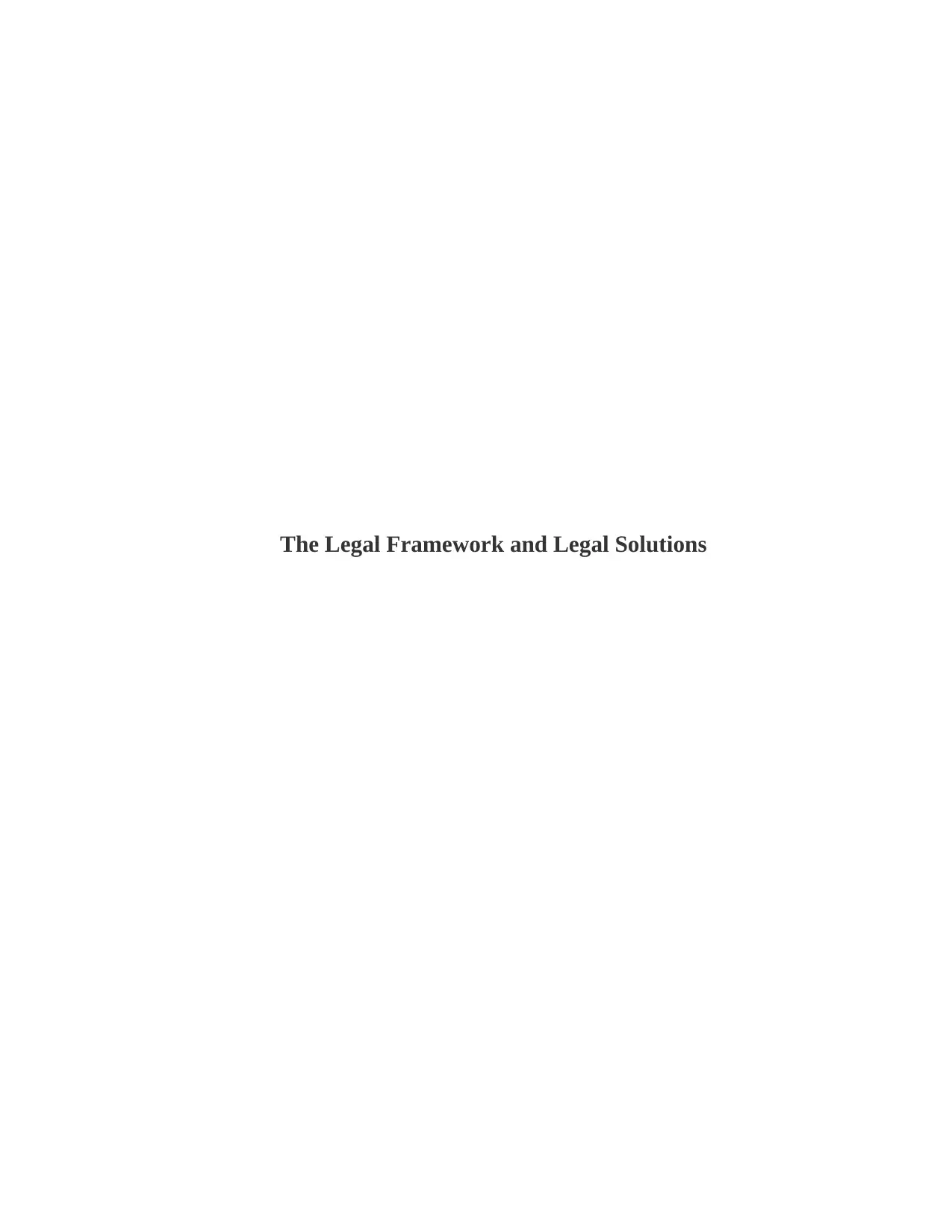
The Legal Framework and Legal Solutions
Paraphrase This Document
Need a fresh take? Get an instant paraphrase of this document with our AI Paraphraser
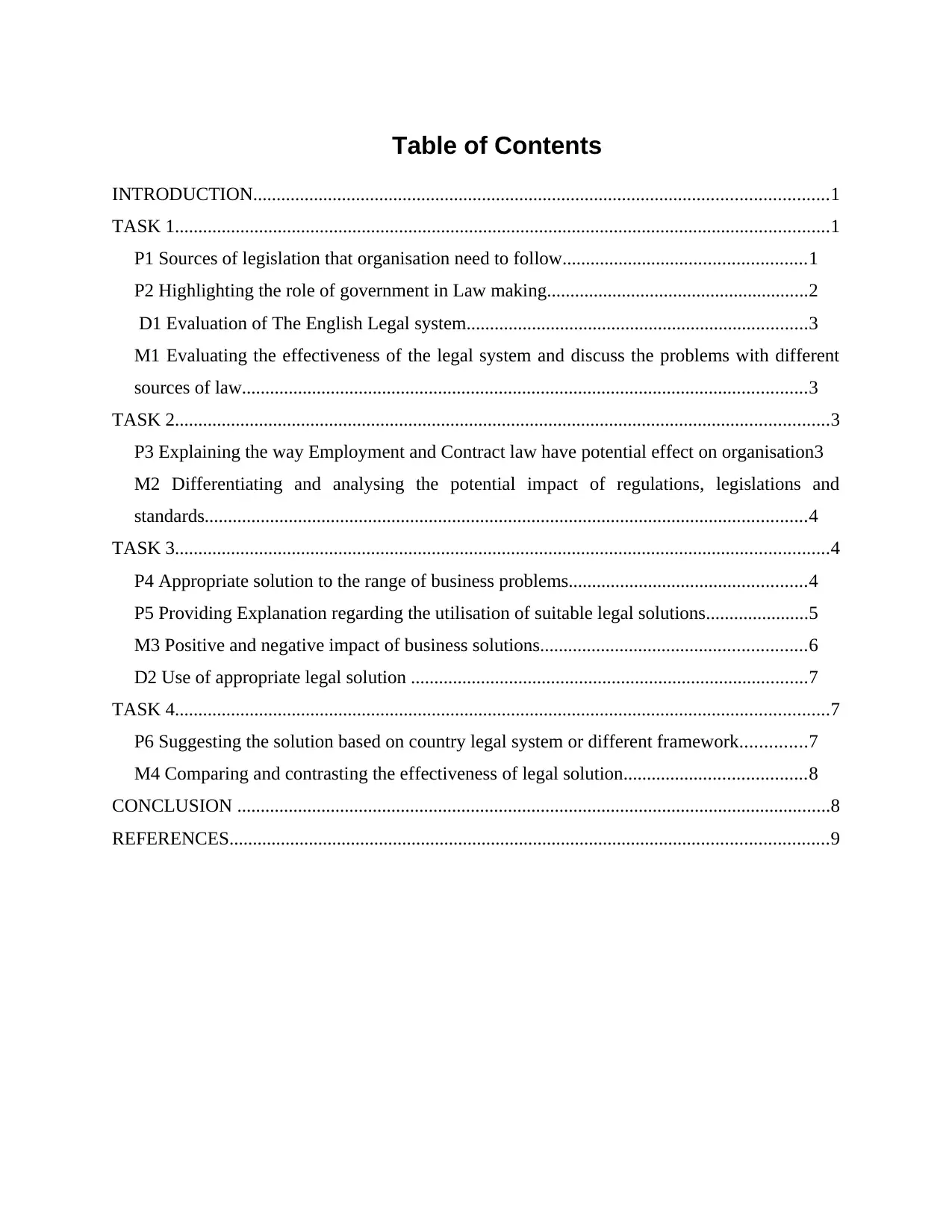
Table of Contents
INTRODUCTION...........................................................................................................................1
TASK 1............................................................................................................................................1
P1 Sources of legislation that organisation need to follow....................................................1
P2 Highlighting the role of government in Law making........................................................2
D1 Evaluation of The English Legal system.........................................................................3
M1 Evaluating the effectiveness of the legal system and discuss the problems with different
sources of law.........................................................................................................................3
TASK 2............................................................................................................................................3
P3 Explaining the way Employment and Contract law have potential effect on organisation3
M2 Differentiating and analysing the potential impact of regulations, legislations and
standards.................................................................................................................................4
TASK 3............................................................................................................................................4
P4 Appropriate solution to the range of business problems...................................................4
P5 Providing Explanation regarding the utilisation of suitable legal solutions......................5
M3 Positive and negative impact of business solutions.........................................................6
D2 Use of appropriate legal solution .....................................................................................7
TASK 4............................................................................................................................................7
P6 Suggesting the solution based on country legal system or different framework..............7
M4 Comparing and contrasting the effectiveness of legal solution.......................................8
CONCLUSION ...............................................................................................................................8
REFERENCES................................................................................................................................9
INTRODUCTION...........................................................................................................................1
TASK 1............................................................................................................................................1
P1 Sources of legislation that organisation need to follow....................................................1
P2 Highlighting the role of government in Law making........................................................2
D1 Evaluation of The English Legal system.........................................................................3
M1 Evaluating the effectiveness of the legal system and discuss the problems with different
sources of law.........................................................................................................................3
TASK 2............................................................................................................................................3
P3 Explaining the way Employment and Contract law have potential effect on organisation3
M2 Differentiating and analysing the potential impact of regulations, legislations and
standards.................................................................................................................................4
TASK 3............................................................................................................................................4
P4 Appropriate solution to the range of business problems...................................................4
P5 Providing Explanation regarding the utilisation of suitable legal solutions......................5
M3 Positive and negative impact of business solutions.........................................................6
D2 Use of appropriate legal solution .....................................................................................7
TASK 4............................................................................................................................................7
P6 Suggesting the solution based on country legal system or different framework..............7
M4 Comparing and contrasting the effectiveness of legal solution.......................................8
CONCLUSION ...............................................................................................................................8
REFERENCES................................................................................................................................9
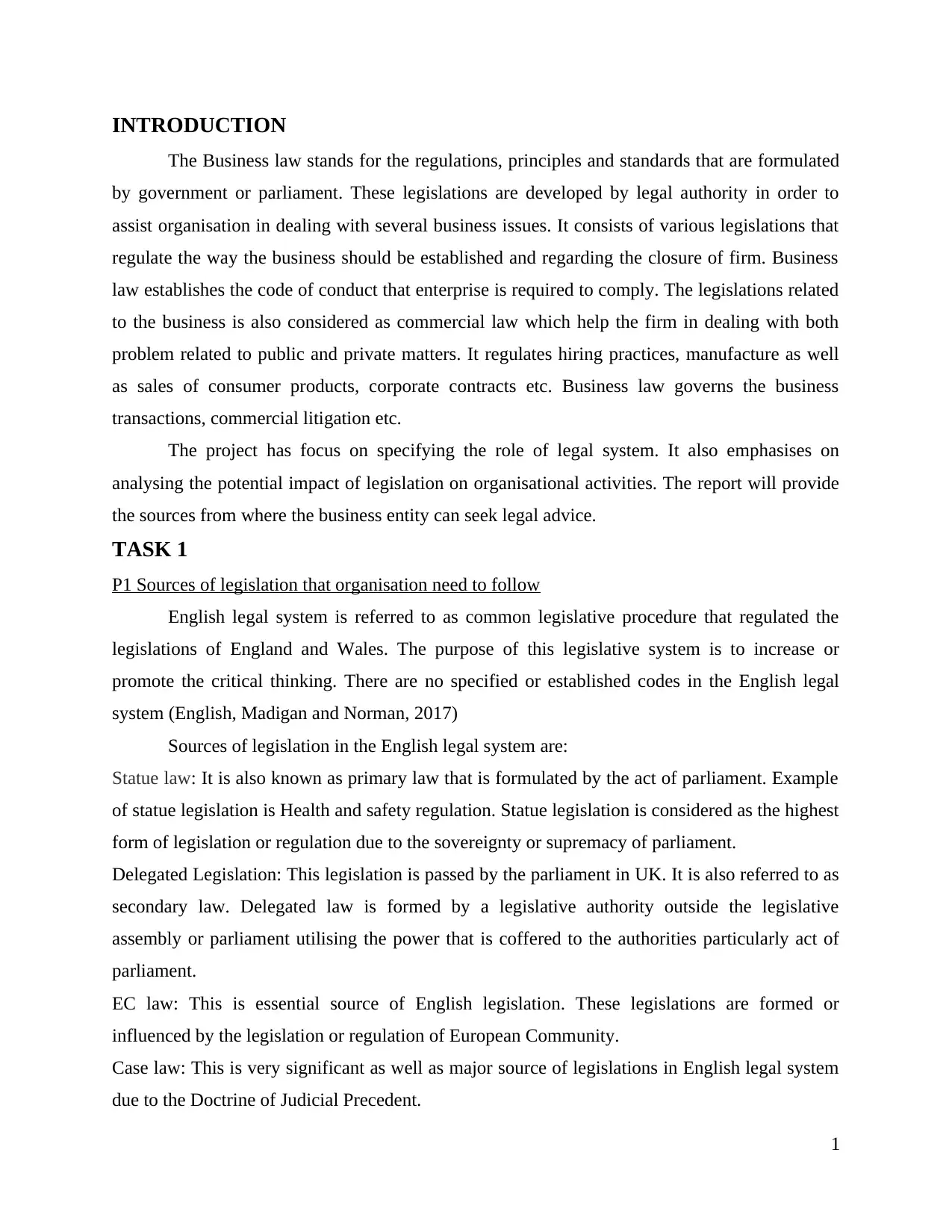
INTRODUCTION
The Business law stands for the regulations, principles and standards that are formulated
by government or parliament. These legislations are developed by legal authority in order to
assist organisation in dealing with several business issues. It consists of various legislations that
regulate the way the business should be established and regarding the closure of firm. Business
law establishes the code of conduct that enterprise is required to comply. The legislations related
to the business is also considered as commercial law which help the firm in dealing with both
problem related to public and private matters. It regulates hiring practices, manufacture as well
as sales of consumer products, corporate contracts etc. Business law governs the business
transactions, commercial litigation etc.
The project has focus on specifying the role of legal system. It also emphasises on
analysing the potential impact of legislation on organisational activities. The report will provide
the sources from where the business entity can seek legal advice.
TASK 1
P1 Sources of legislation that organisation need to follow
English legal system is referred to as common legislative procedure that regulated the
legislations of England and Wales. The purpose of this legislative system is to increase or
promote the critical thinking. There are no specified or established codes in the English legal
system (English, Madigan and Norman, 2017)
Sources of legislation in the English legal system are:
Statue law: It is also known as primary law that is formulated by the act of parliament. Example
of statue legislation is Health and safety regulation. Statue legislation is considered as the highest
form of legislation or regulation due to the sovereignty or supremacy of parliament.
Delegated Legislation: This legislation is passed by the parliament in UK. It is also referred to as
secondary law. Delegated law is formed by a legislative authority outside the legislative
assembly or parliament utilising the power that is coffered to the authorities particularly act of
parliament.
EC law: This is essential source of English legislation. These legislations are formed or
influenced by the legislation or regulation of European Community.
Case law: This is very significant as well as major source of legislations in English legal system
due to the Doctrine of Judicial Precedent.
1
The Business law stands for the regulations, principles and standards that are formulated
by government or parliament. These legislations are developed by legal authority in order to
assist organisation in dealing with several business issues. It consists of various legislations that
regulate the way the business should be established and regarding the closure of firm. Business
law establishes the code of conduct that enterprise is required to comply. The legislations related
to the business is also considered as commercial law which help the firm in dealing with both
problem related to public and private matters. It regulates hiring practices, manufacture as well
as sales of consumer products, corporate contracts etc. Business law governs the business
transactions, commercial litigation etc.
The project has focus on specifying the role of legal system. It also emphasises on
analysing the potential impact of legislation on organisational activities. The report will provide
the sources from where the business entity can seek legal advice.
TASK 1
P1 Sources of legislation that organisation need to follow
English legal system is referred to as common legislative procedure that regulated the
legislations of England and Wales. The purpose of this legislative system is to increase or
promote the critical thinking. There are no specified or established codes in the English legal
system (English, Madigan and Norman, 2017)
Sources of legislation in the English legal system are:
Statue law: It is also known as primary law that is formulated by the act of parliament. Example
of statue legislation is Health and safety regulation. Statue legislation is considered as the highest
form of legislation or regulation due to the sovereignty or supremacy of parliament.
Delegated Legislation: This legislation is passed by the parliament in UK. It is also referred to as
secondary law. Delegated law is formed by a legislative authority outside the legislative
assembly or parliament utilising the power that is coffered to the authorities particularly act of
parliament.
EC law: This is essential source of English legislation. These legislations are formed or
influenced by the legislation or regulation of European Community.
Case law: This is very significant as well as major source of legislations in English legal system
due to the Doctrine of Judicial Precedent.
1
⊘ This is a preview!⊘
Do you want full access?
Subscribe today to unlock all pages.

Trusted by 1+ million students worldwide
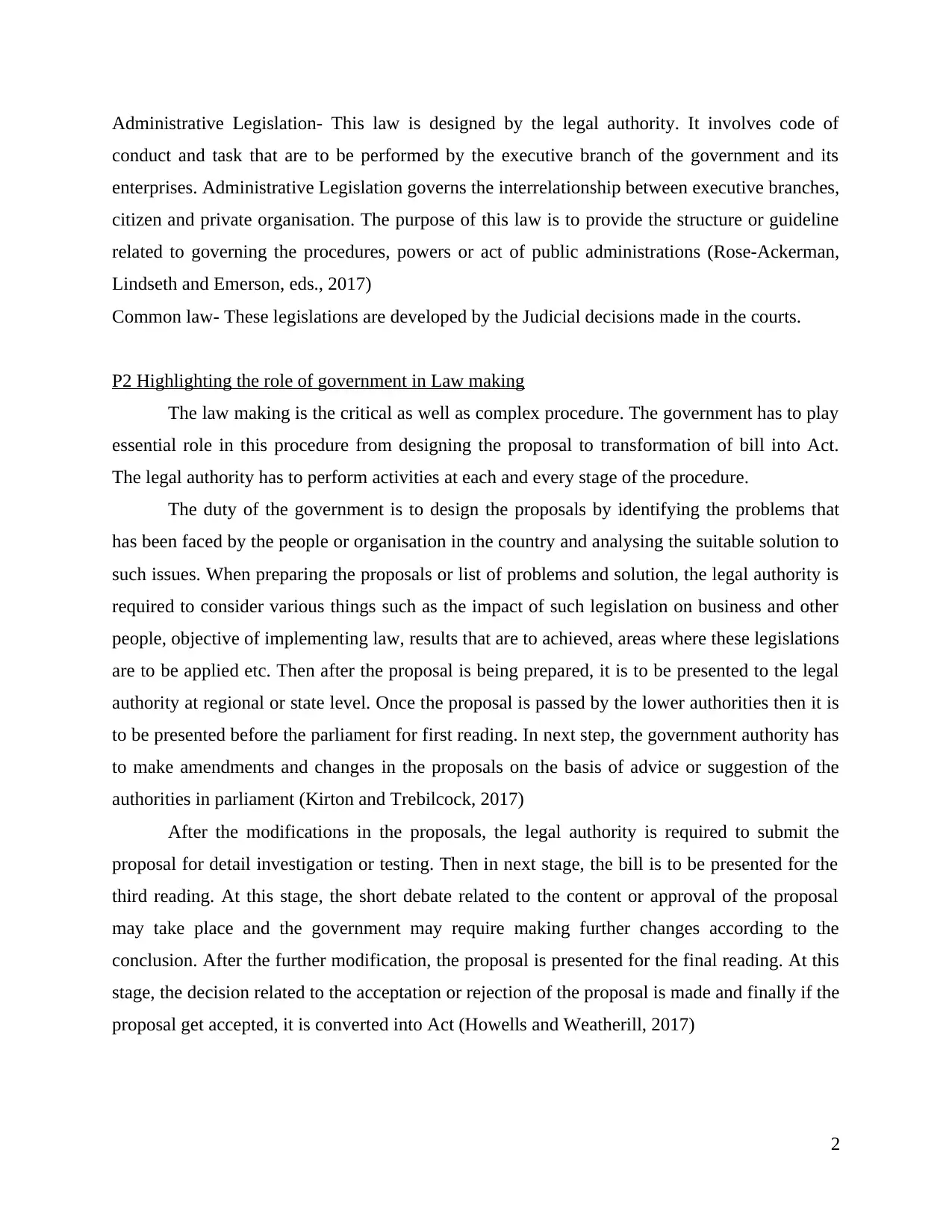
Administrative Legislation- This law is designed by the legal authority. It involves code of
conduct and task that are to be performed by the executive branch of the government and its
enterprises. Administrative Legislation governs the interrelationship between executive branches,
citizen and private organisation. The purpose of this law is to provide the structure or guideline
related to governing the procedures, powers or act of public administrations (Rose-Ackerman,
Lindseth and Emerson, eds., 2017)
Common law- These legislations are developed by the Judicial decisions made in the courts.
P2 Highlighting the role of government in Law making
The law making is the critical as well as complex procedure. The government has to play
essential role in this procedure from designing the proposal to transformation of bill into Act.
The legal authority has to perform activities at each and every stage of the procedure.
The duty of the government is to design the proposals by identifying the problems that
has been faced by the people or organisation in the country and analysing the suitable solution to
such issues. When preparing the proposals or list of problems and solution, the legal authority is
required to consider various things such as the impact of such legislation on business and other
people, objective of implementing law, results that are to achieved, areas where these legislations
are to be applied etc. Then after the proposal is being prepared, it is to be presented to the legal
authority at regional or state level. Once the proposal is passed by the lower authorities then it is
to be presented before the parliament for first reading. In next step, the government authority has
to make amendments and changes in the proposals on the basis of advice or suggestion of the
authorities in parliament (Kirton and Trebilcock, 2017)
After the modifications in the proposals, the legal authority is required to submit the
proposal for detail investigation or testing. Then in next stage, the bill is to be presented for the
third reading. At this stage, the short debate related to the content or approval of the proposal
may take place and the government may require making further changes according to the
conclusion. After the further modification, the proposal is presented for the final reading. At this
stage, the decision related to the acceptation or rejection of the proposal is made and finally if the
proposal get accepted, it is converted into Act (Howells and Weatherill, 2017)
2
conduct and task that are to be performed by the executive branch of the government and its
enterprises. Administrative Legislation governs the interrelationship between executive branches,
citizen and private organisation. The purpose of this law is to provide the structure or guideline
related to governing the procedures, powers or act of public administrations (Rose-Ackerman,
Lindseth and Emerson, eds., 2017)
Common law- These legislations are developed by the Judicial decisions made in the courts.
P2 Highlighting the role of government in Law making
The law making is the critical as well as complex procedure. The government has to play
essential role in this procedure from designing the proposal to transformation of bill into Act.
The legal authority has to perform activities at each and every stage of the procedure.
The duty of the government is to design the proposals by identifying the problems that
has been faced by the people or organisation in the country and analysing the suitable solution to
such issues. When preparing the proposals or list of problems and solution, the legal authority is
required to consider various things such as the impact of such legislation on business and other
people, objective of implementing law, results that are to achieved, areas where these legislations
are to be applied etc. Then after the proposal is being prepared, it is to be presented to the legal
authority at regional or state level. Once the proposal is passed by the lower authorities then it is
to be presented before the parliament for first reading. In next step, the government authority has
to make amendments and changes in the proposals on the basis of advice or suggestion of the
authorities in parliament (Kirton and Trebilcock, 2017)
After the modifications in the proposals, the legal authority is required to submit the
proposal for detail investigation or testing. Then in next stage, the bill is to be presented for the
third reading. At this stage, the short debate related to the content or approval of the proposal
may take place and the government may require making further changes according to the
conclusion. After the further modification, the proposal is presented for the final reading. At this
stage, the decision related to the acceptation or rejection of the proposal is made and finally if the
proposal get accepted, it is converted into Act (Howells and Weatherill, 2017)
2
Paraphrase This Document
Need a fresh take? Get an instant paraphrase of this document with our AI Paraphraser
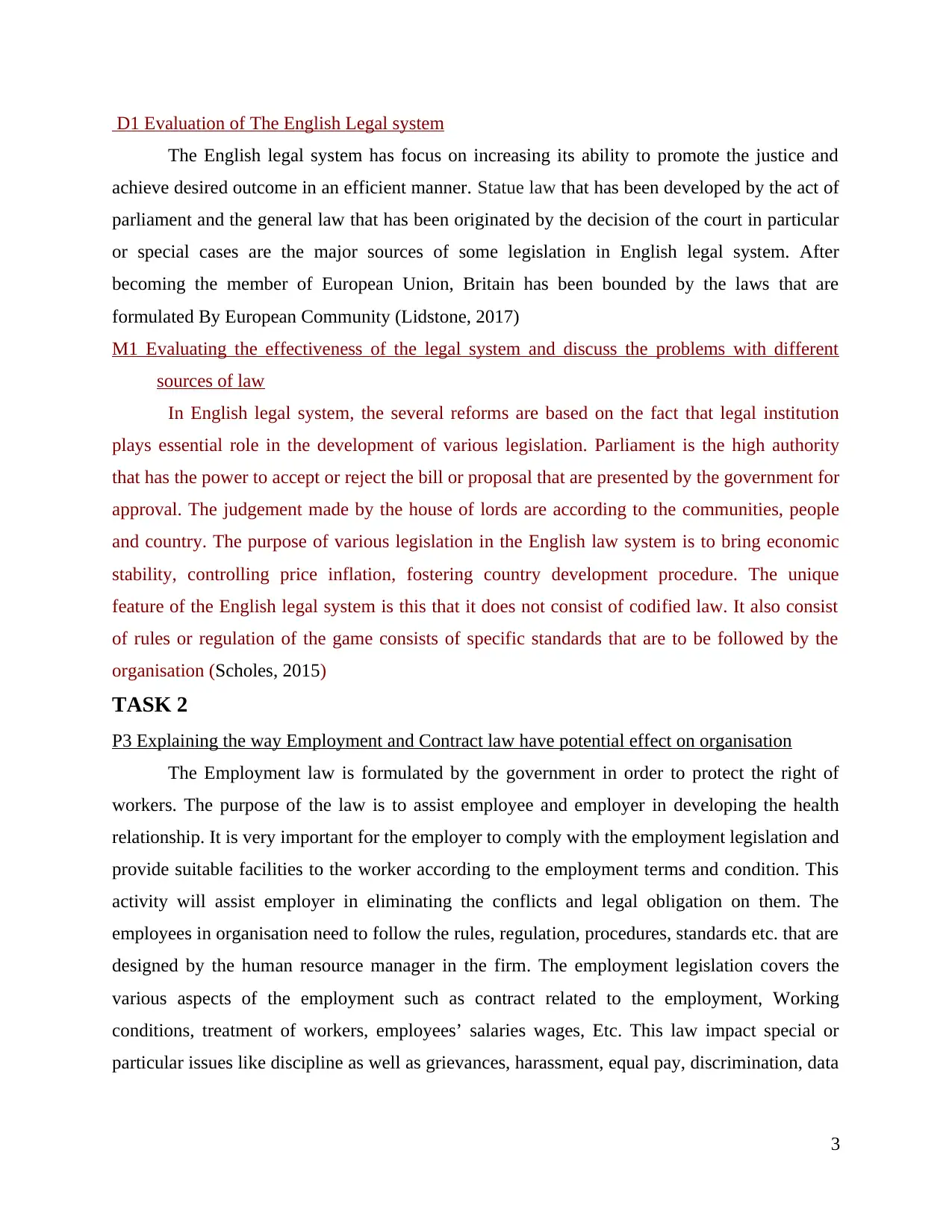
D1 Evaluation of The English Legal system
The English legal system has focus on increasing its ability to promote the justice and
achieve desired outcome in an efficient manner. Statue law that has been developed by the act of
parliament and the general law that has been originated by the decision of the court in particular
or special cases are the major sources of some legislation in English legal system. After
becoming the member of European Union, Britain has been bounded by the laws that are
formulated By European Community (Lidstone, 2017)
M1 Evaluating the effectiveness of the legal system and discuss the problems with different
sources of law
In English legal system, the several reforms are based on the fact that legal institution
plays essential role in the development of various legislation. Parliament is the high authority
that has the power to accept or reject the bill or proposal that are presented by the government for
approval. The judgement made by the house of lords are according to the communities, people
and country. The purpose of various legislation in the English law system is to bring economic
stability, controlling price inflation, fostering country development procedure. The unique
feature of the English legal system is this that it does not consist of codified law. It also consist
of rules or regulation of the game consists of specific standards that are to be followed by the
organisation (Scholes, 2015)
TASK 2
P3 Explaining the way Employment and Contract law have potential effect on organisation
The Employment law is formulated by the government in order to protect the right of
workers. The purpose of the law is to assist employee and employer in developing the health
relationship. It is very important for the employer to comply with the employment legislation and
provide suitable facilities to the worker according to the employment terms and condition. This
activity will assist employer in eliminating the conflicts and legal obligation on them. The
employees in organisation need to follow the rules, regulation, procedures, standards etc. that are
designed by the human resource manager in the firm. The employment legislation covers the
various aspects of the employment such as contract related to the employment, Working
conditions, treatment of workers, employees’ salaries wages, Etc. This law impact special or
particular issues like discipline as well as grievances, harassment, equal pay, discrimination, data
3
The English legal system has focus on increasing its ability to promote the justice and
achieve desired outcome in an efficient manner. Statue law that has been developed by the act of
parliament and the general law that has been originated by the decision of the court in particular
or special cases are the major sources of some legislation in English legal system. After
becoming the member of European Union, Britain has been bounded by the laws that are
formulated By European Community (Lidstone, 2017)
M1 Evaluating the effectiveness of the legal system and discuss the problems with different
sources of law
In English legal system, the several reforms are based on the fact that legal institution
plays essential role in the development of various legislation. Parliament is the high authority
that has the power to accept or reject the bill or proposal that are presented by the government for
approval. The judgement made by the house of lords are according to the communities, people
and country. The purpose of various legislation in the English law system is to bring economic
stability, controlling price inflation, fostering country development procedure. The unique
feature of the English legal system is this that it does not consist of codified law. It also consist
of rules or regulation of the game consists of specific standards that are to be followed by the
organisation (Scholes, 2015)
TASK 2
P3 Explaining the way Employment and Contract law have potential effect on organisation
The Employment law is formulated by the government in order to protect the right of
workers. The purpose of the law is to assist employee and employer in developing the health
relationship. It is very important for the employer to comply with the employment legislation and
provide suitable facilities to the worker according to the employment terms and condition. This
activity will assist employer in eliminating the conflicts and legal obligation on them. The
employees in organisation need to follow the rules, regulation, procedures, standards etc. that are
designed by the human resource manager in the firm. The employment legislation covers the
various aspects of the employment such as contract related to the employment, Working
conditions, treatment of workers, employees’ salaries wages, Etc. This law impact special or
particular issues like discipline as well as grievances, harassment, equal pay, discrimination, data
3
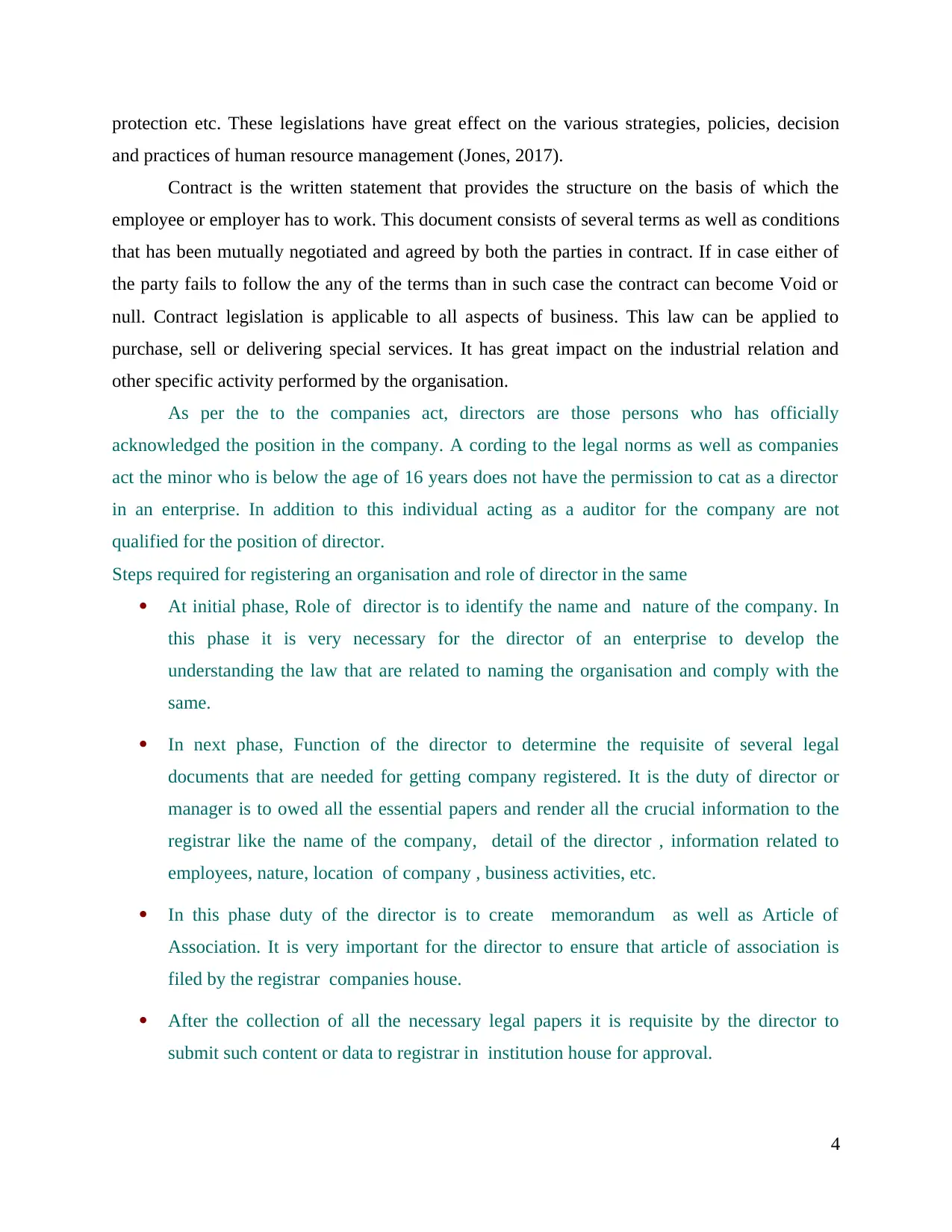
protection etc. These legislations have great effect on the various strategies, policies, decision
and practices of human resource management (Jones, 2017).
Contract is the written statement that provides the structure on the basis of which the
employee or employer has to work. This document consists of several terms as well as conditions
that has been mutually negotiated and agreed by both the parties in contract. If in case either of
the party fails to follow the any of the terms than in such case the contract can become Void or
null. Contract legislation is applicable to all aspects of business. This law can be applied to
purchase, sell or delivering special services. It has great impact on the industrial relation and
other specific activity performed by the organisation.
As per the to the companies act, directors are those persons who has officially
acknowledged the position in the company. A cording to the legal norms as well as companies
act the minor who is below the age of 16 years does not have the permission to cat as a director
in an enterprise. In addition to this individual acting as a auditor for the company are not
qualified for the position of director.
Steps required for registering an organisation and role of director in the same
At initial phase, Role of director is to identify the name and nature of the company. In
this phase it is very necessary for the director of an enterprise to develop the
understanding the law that are related to naming the organisation and comply with the
same.
In next phase, Function of the director to determine the requisite of several legal
documents that are needed for getting company registered. It is the duty of director or
manager is to owed all the essential papers and render all the crucial information to the
registrar like the name of the company, detail of the director , information related to
employees, nature, location of company , business activities, etc.
In this phase duty of the director is to create memorandum as well as Article of
Association. It is very important for the director to ensure that article of association is
filed by the registrar companies house.
After the collection of all the necessary legal papers it is requisite by the director to
submit such content or data to registrar in institution house for approval.
4
and practices of human resource management (Jones, 2017).
Contract is the written statement that provides the structure on the basis of which the
employee or employer has to work. This document consists of several terms as well as conditions
that has been mutually negotiated and agreed by both the parties in contract. If in case either of
the party fails to follow the any of the terms than in such case the contract can become Void or
null. Contract legislation is applicable to all aspects of business. This law can be applied to
purchase, sell or delivering special services. It has great impact on the industrial relation and
other specific activity performed by the organisation.
As per the to the companies act, directors are those persons who has officially
acknowledged the position in the company. A cording to the legal norms as well as companies
act the minor who is below the age of 16 years does not have the permission to cat as a director
in an enterprise. In addition to this individual acting as a auditor for the company are not
qualified for the position of director.
Steps required for registering an organisation and role of director in the same
At initial phase, Role of director is to identify the name and nature of the company. In
this phase it is very necessary for the director of an enterprise to develop the
understanding the law that are related to naming the organisation and comply with the
same.
In next phase, Function of the director to determine the requisite of several legal
documents that are needed for getting company registered. It is the duty of director or
manager is to owed all the essential papers and render all the crucial information to the
registrar like the name of the company, detail of the director , information related to
employees, nature, location of company , business activities, etc.
In this phase duty of the director is to create memorandum as well as Article of
Association. It is very important for the director to ensure that article of association is
filed by the registrar companies house.
After the collection of all the necessary legal papers it is requisite by the director to
submit such content or data to registrar in institution house for approval.
4
⊘ This is a preview!⊘
Do you want full access?
Subscribe today to unlock all pages.

Trusted by 1+ million students worldwide
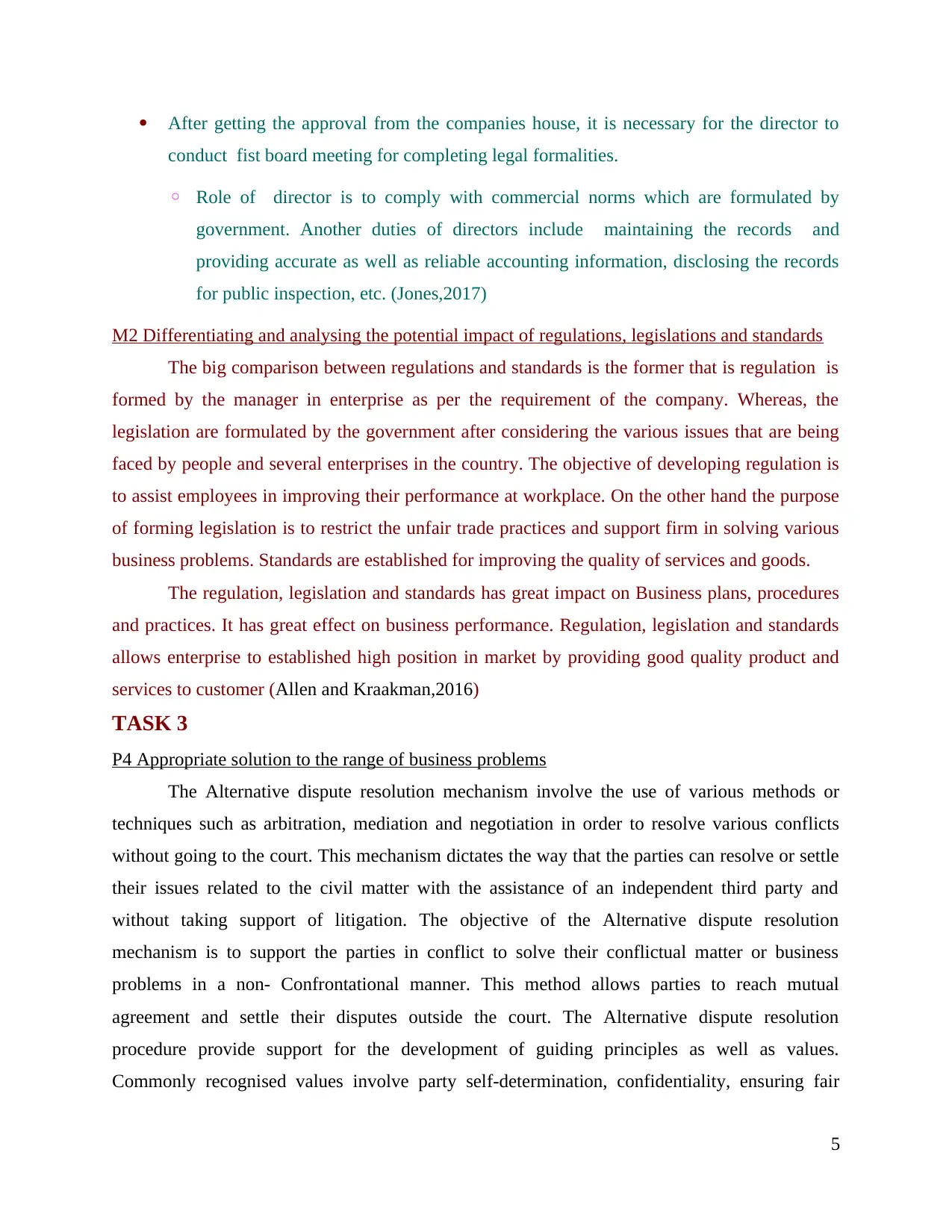
After getting the approval from the companies house, it is necessary for the director to
conduct fist board meeting for completing legal formalities.
◦ Role of director is to comply with commercial norms which are formulated by
government. Another duties of directors include maintaining the records and
providing accurate as well as reliable accounting information, disclosing the records
for public inspection, etc. (Jones,2017)
M2 Differentiating and analysing the potential impact of regulations, legislations and standards
The big comparison between regulations and standards is the former that is regulation is
formed by the manager in enterprise as per the requirement of the company. Whereas, the
legislation are formulated by the government after considering the various issues that are being
faced by people and several enterprises in the country. The objective of developing regulation is
to assist employees in improving their performance at workplace. On the other hand the purpose
of forming legislation is to restrict the unfair trade practices and support firm in solving various
business problems. Standards are established for improving the quality of services and goods.
The regulation, legislation and standards has great impact on Business plans, procedures
and practices. It has great effect on business performance. Regulation, legislation and standards
allows enterprise to established high position in market by providing good quality product and
services to customer (Allen and Kraakman,2016)
TASK 3
P4 Appropriate solution to the range of business problems
The Alternative dispute resolution mechanism involve the use of various methods or
techniques such as arbitration, mediation and negotiation in order to resolve various conflicts
without going to the court. This mechanism dictates the way that the parties can resolve or settle
their issues related to the civil matter with the assistance of an independent third party and
without taking support of litigation. The objective of the Alternative dispute resolution
mechanism is to support the parties in conflict to solve their conflictual matter or business
problems in a non- Confrontational manner. This method allows parties to reach mutual
agreement and settle their disputes outside the court. The Alternative dispute resolution
procedure provide support for the development of guiding principles as well as values.
Commonly recognised values involve party self-determination, confidentiality, ensuring fair
5
conduct fist board meeting for completing legal formalities.
◦ Role of director is to comply with commercial norms which are formulated by
government. Another duties of directors include maintaining the records and
providing accurate as well as reliable accounting information, disclosing the records
for public inspection, etc. (Jones,2017)
M2 Differentiating and analysing the potential impact of regulations, legislations and standards
The big comparison between regulations and standards is the former that is regulation is
formed by the manager in enterprise as per the requirement of the company. Whereas, the
legislation are formulated by the government after considering the various issues that are being
faced by people and several enterprises in the country. The objective of developing regulation is
to assist employees in improving their performance at workplace. On the other hand the purpose
of forming legislation is to restrict the unfair trade practices and support firm in solving various
business problems. Standards are established for improving the quality of services and goods.
The regulation, legislation and standards has great impact on Business plans, procedures
and practices. It has great effect on business performance. Regulation, legislation and standards
allows enterprise to established high position in market by providing good quality product and
services to customer (Allen and Kraakman,2016)
TASK 3
P4 Appropriate solution to the range of business problems
The Alternative dispute resolution mechanism involve the use of various methods or
techniques such as arbitration, mediation and negotiation in order to resolve various conflicts
without going to the court. This mechanism dictates the way that the parties can resolve or settle
their issues related to the civil matter with the assistance of an independent third party and
without taking support of litigation. The objective of the Alternative dispute resolution
mechanism is to support the parties in conflict to solve their conflictual matter or business
problems in a non- Confrontational manner. This method allows parties to reach mutual
agreement and settle their disputes outside the court. The Alternative dispute resolution
procedure provide support for the development of guiding principles as well as values.
Commonly recognised values involve party self-determination, confidentiality, ensuring fair
5
Paraphrase This Document
Need a fresh take? Get an instant paraphrase of this document with our AI Paraphraser
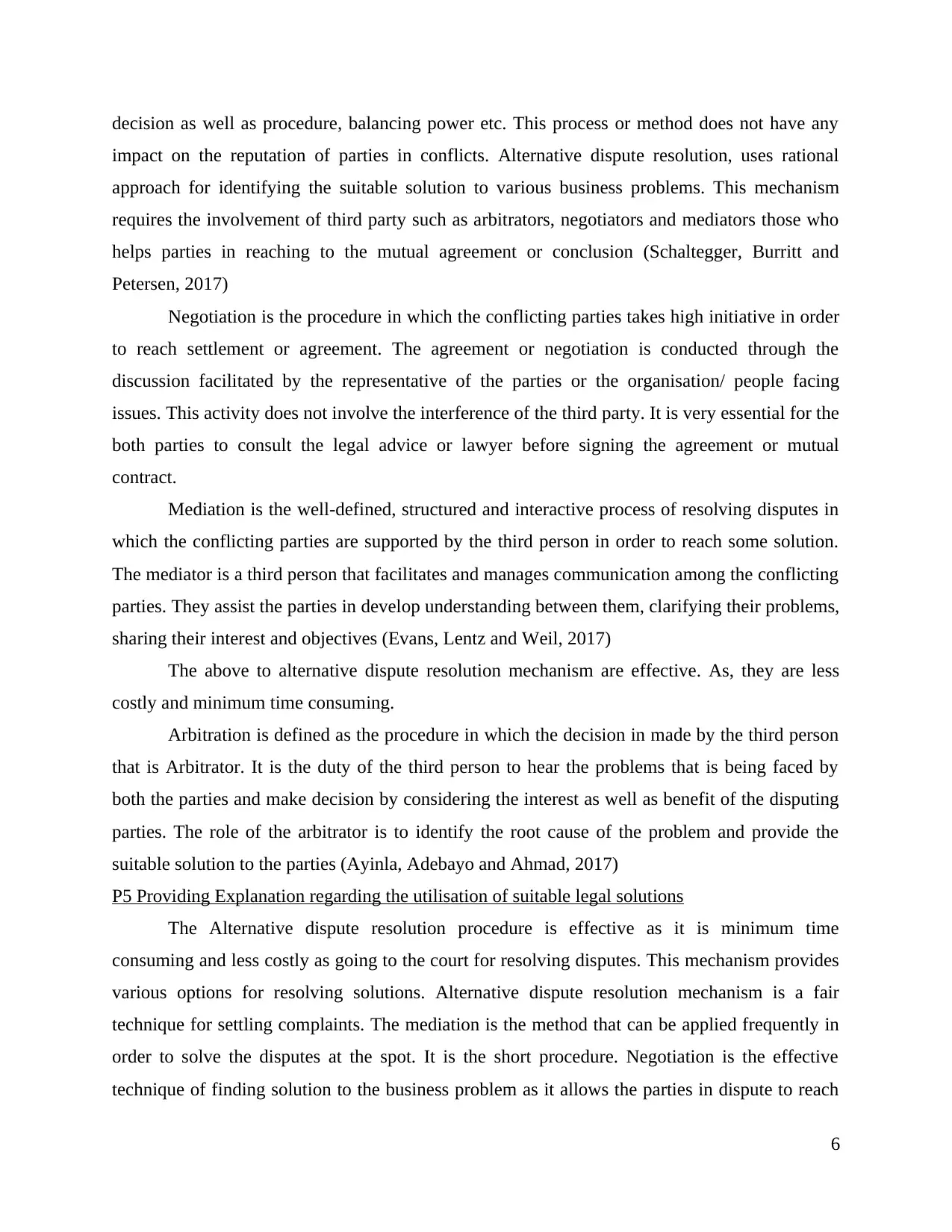
decision as well as procedure, balancing power etc. This process or method does not have any
impact on the reputation of parties in conflicts. Alternative dispute resolution, uses rational
approach for identifying the suitable solution to various business problems. This mechanism
requires the involvement of third party such as arbitrators, negotiators and mediators those who
helps parties in reaching to the mutual agreement or conclusion (Schaltegger, Burritt and
Petersen, 2017)
Negotiation is the procedure in which the conflicting parties takes high initiative in order
to reach settlement or agreement. The agreement or negotiation is conducted through the
discussion facilitated by the representative of the parties or the organisation/ people facing
issues. This activity does not involve the interference of the third party. It is very essential for the
both parties to consult the legal advice or lawyer before signing the agreement or mutual
contract.
Mediation is the well-defined, structured and interactive process of resolving disputes in
which the conflicting parties are supported by the third person in order to reach some solution.
The mediator is a third person that facilitates and manages communication among the conflicting
parties. They assist the parties in develop understanding between them, clarifying their problems,
sharing their interest and objectives (Evans, Lentz and Weil, 2017)
The above to alternative dispute resolution mechanism are effective. As, they are less
costly and minimum time consuming.
Arbitration is defined as the procedure in which the decision in made by the third person
that is Arbitrator. It is the duty of the third person to hear the problems that is being faced by
both the parties and make decision by considering the interest as well as benefit of the disputing
parties. The role of the arbitrator is to identify the root cause of the problem and provide the
suitable solution to the parties (Ayinla, Adebayo and Ahmad, 2017)
P5 Providing Explanation regarding the utilisation of suitable legal solutions
The Alternative dispute resolution procedure is effective as it is minimum time
consuming and less costly as going to the court for resolving disputes. This mechanism provides
various options for resolving solutions. Alternative dispute resolution mechanism is a fair
technique for settling complaints. The mediation is the method that can be applied frequently in
order to solve the disputes at the spot. It is the short procedure. Negotiation is the effective
technique of finding solution to the business problem as it allows the parties in dispute to reach
6
impact on the reputation of parties in conflicts. Alternative dispute resolution, uses rational
approach for identifying the suitable solution to various business problems. This mechanism
requires the involvement of third party such as arbitrators, negotiators and mediators those who
helps parties in reaching to the mutual agreement or conclusion (Schaltegger, Burritt and
Petersen, 2017)
Negotiation is the procedure in which the conflicting parties takes high initiative in order
to reach settlement or agreement. The agreement or negotiation is conducted through the
discussion facilitated by the representative of the parties or the organisation/ people facing
issues. This activity does not involve the interference of the third party. It is very essential for the
both parties to consult the legal advice or lawyer before signing the agreement or mutual
contract.
Mediation is the well-defined, structured and interactive process of resolving disputes in
which the conflicting parties are supported by the third person in order to reach some solution.
The mediator is a third person that facilitates and manages communication among the conflicting
parties. They assist the parties in develop understanding between them, clarifying their problems,
sharing their interest and objectives (Evans, Lentz and Weil, 2017)
The above to alternative dispute resolution mechanism are effective. As, they are less
costly and minimum time consuming.
Arbitration is defined as the procedure in which the decision in made by the third person
that is Arbitrator. It is the duty of the third person to hear the problems that is being faced by
both the parties and make decision by considering the interest as well as benefit of the disputing
parties. The role of the arbitrator is to identify the root cause of the problem and provide the
suitable solution to the parties (Ayinla, Adebayo and Ahmad, 2017)
P5 Providing Explanation regarding the utilisation of suitable legal solutions
The Alternative dispute resolution procedure is effective as it is minimum time
consuming and less costly as going to the court for resolving disputes. This mechanism provides
various options for resolving solutions. Alternative dispute resolution mechanism is a fair
technique for settling complaints. The mediation is the method that can be applied frequently in
order to solve the disputes at the spot. It is the short procedure. Negotiation is the effective
technique of finding solution to the business problem as it allows the parties in dispute to reach
6
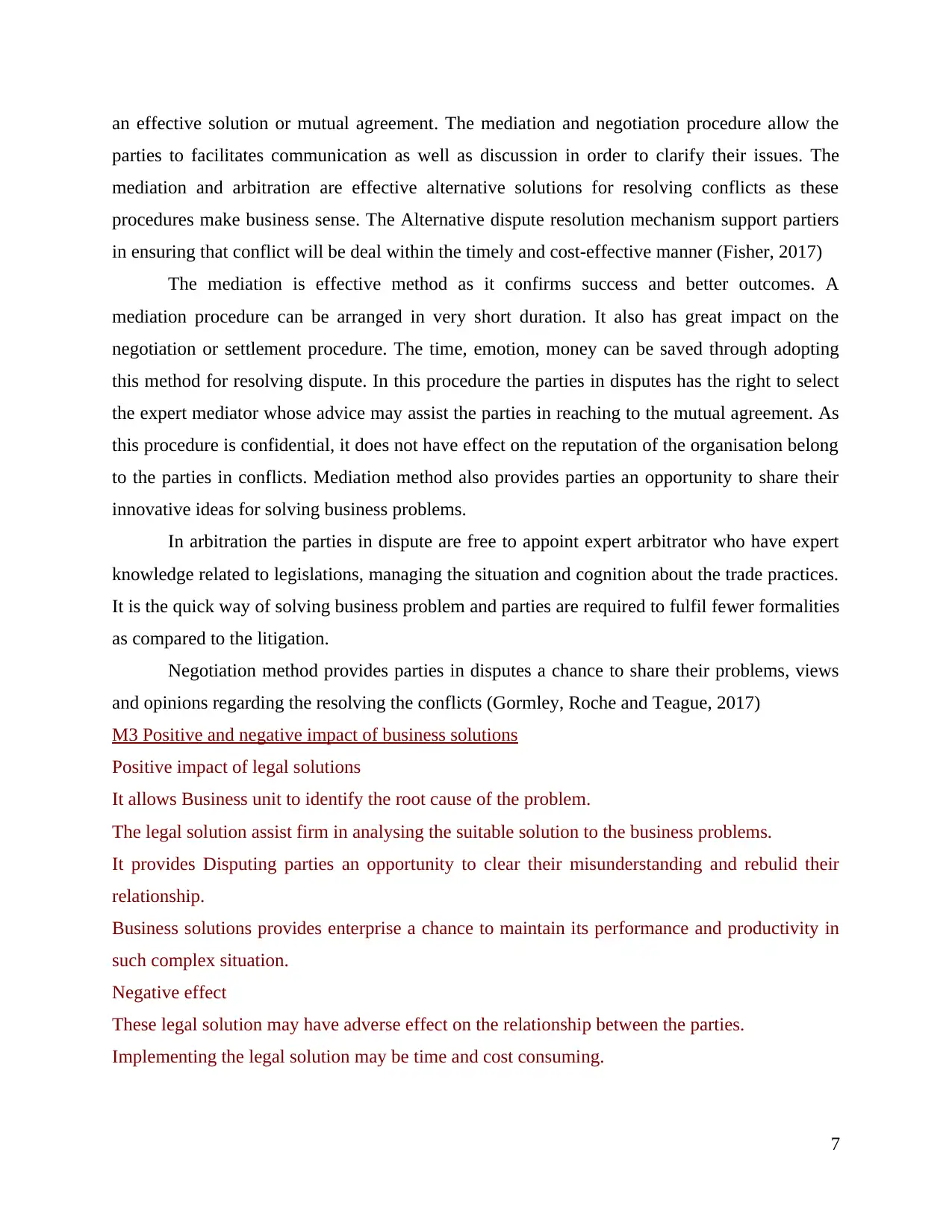
an effective solution or mutual agreement. The mediation and negotiation procedure allow the
parties to facilitates communication as well as discussion in order to clarify their issues. The
mediation and arbitration are effective alternative solutions for resolving conflicts as these
procedures make business sense. The Alternative dispute resolution mechanism support partiers
in ensuring that conflict will be deal within the timely and cost-effective manner (Fisher, 2017)
The mediation is effective method as it confirms success and better outcomes. A
mediation procedure can be arranged in very short duration. It also has great impact on the
negotiation or settlement procedure. The time, emotion, money can be saved through adopting
this method for resolving dispute. In this procedure the parties in disputes has the right to select
the expert mediator whose advice may assist the parties in reaching to the mutual agreement. As
this procedure is confidential, it does not have effect on the reputation of the organisation belong
to the parties in conflicts. Mediation method also provides parties an opportunity to share their
innovative ideas for solving business problems.
In arbitration the parties in dispute are free to appoint expert arbitrator who have expert
knowledge related to legislations, managing the situation and cognition about the trade practices.
It is the quick way of solving business problem and parties are required to fulfil fewer formalities
as compared to the litigation.
Negotiation method provides parties in disputes a chance to share their problems, views
and opinions regarding the resolving the conflicts (Gormley, Roche and Teague, 2017)
M3 Positive and negative impact of business solutions
Positive impact of legal solutions
It allows Business unit to identify the root cause of the problem.
The legal solution assist firm in analysing the suitable solution to the business problems.
It provides Disputing parties an opportunity to clear their misunderstanding and rebulid their
relationship.
Business solutions provides enterprise a chance to maintain its performance and productivity in
such complex situation.
Negative effect
These legal solution may have adverse effect on the relationship between the parties.
Implementing the legal solution may be time and cost consuming.
7
parties to facilitates communication as well as discussion in order to clarify their issues. The
mediation and arbitration are effective alternative solutions for resolving conflicts as these
procedures make business sense. The Alternative dispute resolution mechanism support partiers
in ensuring that conflict will be deal within the timely and cost-effective manner (Fisher, 2017)
The mediation is effective method as it confirms success and better outcomes. A
mediation procedure can be arranged in very short duration. It also has great impact on the
negotiation or settlement procedure. The time, emotion, money can be saved through adopting
this method for resolving dispute. In this procedure the parties in disputes has the right to select
the expert mediator whose advice may assist the parties in reaching to the mutual agreement. As
this procedure is confidential, it does not have effect on the reputation of the organisation belong
to the parties in conflicts. Mediation method also provides parties an opportunity to share their
innovative ideas for solving business problems.
In arbitration the parties in dispute are free to appoint expert arbitrator who have expert
knowledge related to legislations, managing the situation and cognition about the trade practices.
It is the quick way of solving business problem and parties are required to fulfil fewer formalities
as compared to the litigation.
Negotiation method provides parties in disputes a chance to share their problems, views
and opinions regarding the resolving the conflicts (Gormley, Roche and Teague, 2017)
M3 Positive and negative impact of business solutions
Positive impact of legal solutions
It allows Business unit to identify the root cause of the problem.
The legal solution assist firm in analysing the suitable solution to the business problems.
It provides Disputing parties an opportunity to clear their misunderstanding and rebulid their
relationship.
Business solutions provides enterprise a chance to maintain its performance and productivity in
such complex situation.
Negative effect
These legal solution may have adverse effect on the relationship between the parties.
Implementing the legal solution may be time and cost consuming.
7
⊘ This is a preview!⊘
Do you want full access?
Subscribe today to unlock all pages.

Trusted by 1+ million students worldwide
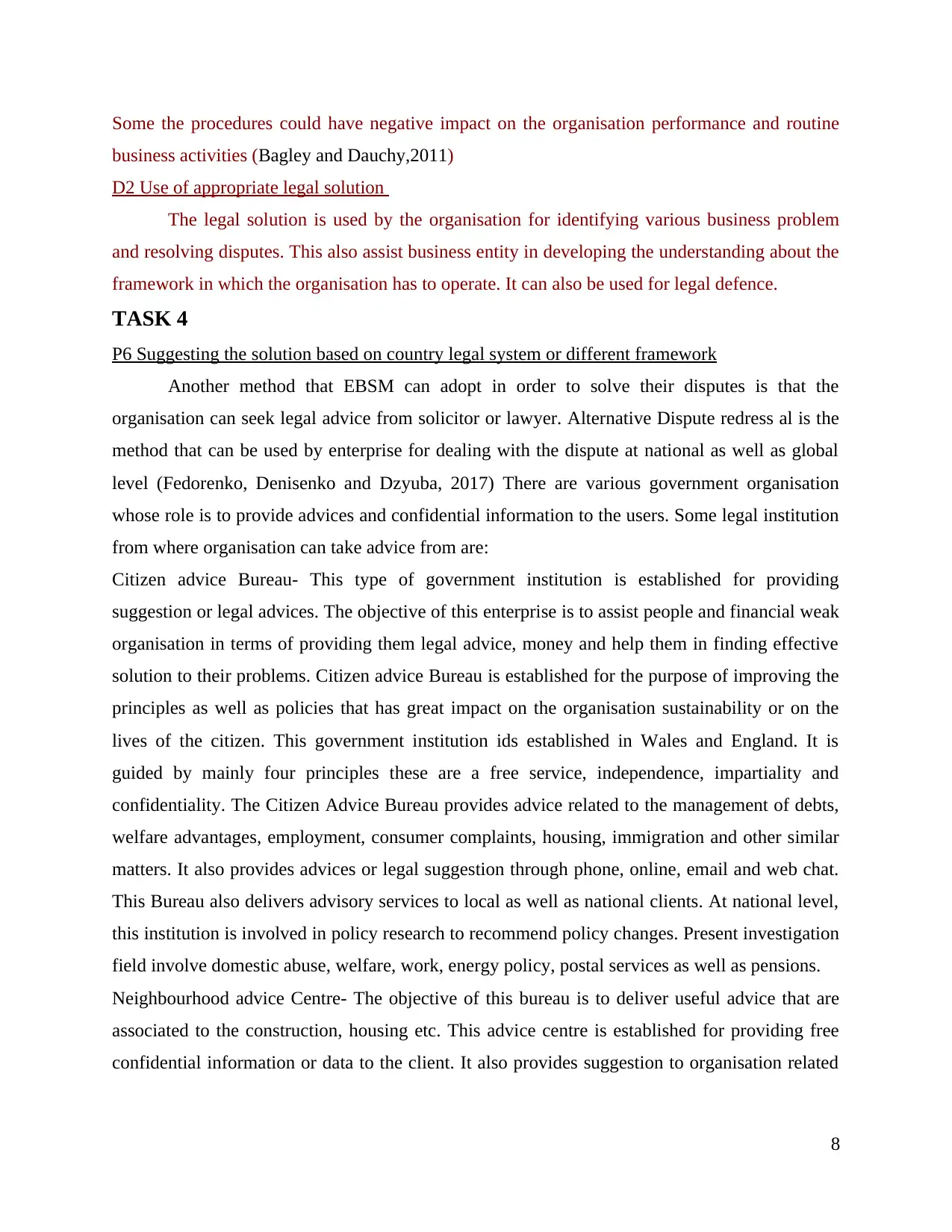
Some the procedures could have negative impact on the organisation performance and routine
business activities (Bagley and Dauchy,2011)
D2 Use of appropriate legal solution
The legal solution is used by the organisation for identifying various business problem
and resolving disputes. This also assist business entity in developing the understanding about the
framework in which the organisation has to operate. It can also be used for legal defence.
TASK 4
P6 Suggesting the solution based on country legal system or different framework
Another method that EBSM can adopt in order to solve their disputes is that the
organisation can seek legal advice from solicitor or lawyer. Alternative Dispute redress al is the
method that can be used by enterprise for dealing with the dispute at national as well as global
level (Fedorenko, Denisenko and Dzyuba, 2017) There are various government organisation
whose role is to provide advices and confidential information to the users. Some legal institution
from where organisation can take advice from are:
Citizen advice Bureau- This type of government institution is established for providing
suggestion or legal advices. The objective of this enterprise is to assist people and financial weak
organisation in terms of providing them legal advice, money and help them in finding effective
solution to their problems. Citizen advice Bureau is established for the purpose of improving the
principles as well as policies that has great impact on the organisation sustainability or on the
lives of the citizen. This government institution ids established in Wales and England. It is
guided by mainly four principles these are a free service, independence, impartiality and
confidentiality. The Citizen Advice Bureau provides advice related to the management of debts,
welfare advantages, employment, consumer complaints, housing, immigration and other similar
matters. It also provides advices or legal suggestion through phone, online, email and web chat.
This Bureau also delivers advisory services to local as well as national clients. At national level,
this institution is involved in policy research to recommend policy changes. Present investigation
field involve domestic abuse, welfare, work, energy policy, postal services as well as pensions.
Neighbourhood advice Centre- The objective of this bureau is to deliver useful advice that are
associated to the construction, housing etc. This advice centre is established for providing free
confidential information or data to the client. It also provides suggestion to organisation related
8
business activities (Bagley and Dauchy,2011)
D2 Use of appropriate legal solution
The legal solution is used by the organisation for identifying various business problem
and resolving disputes. This also assist business entity in developing the understanding about the
framework in which the organisation has to operate. It can also be used for legal defence.
TASK 4
P6 Suggesting the solution based on country legal system or different framework
Another method that EBSM can adopt in order to solve their disputes is that the
organisation can seek legal advice from solicitor or lawyer. Alternative Dispute redress al is the
method that can be used by enterprise for dealing with the dispute at national as well as global
level (Fedorenko, Denisenko and Dzyuba, 2017) There are various government organisation
whose role is to provide advices and confidential information to the users. Some legal institution
from where organisation can take advice from are:
Citizen advice Bureau- This type of government institution is established for providing
suggestion or legal advices. The objective of this enterprise is to assist people and financial weak
organisation in terms of providing them legal advice, money and help them in finding effective
solution to their problems. Citizen advice Bureau is established for the purpose of improving the
principles as well as policies that has great impact on the organisation sustainability or on the
lives of the citizen. This government institution ids established in Wales and England. It is
guided by mainly four principles these are a free service, independence, impartiality and
confidentiality. The Citizen Advice Bureau provides advice related to the management of debts,
welfare advantages, employment, consumer complaints, housing, immigration and other similar
matters. It also provides advices or legal suggestion through phone, online, email and web chat.
This Bureau also delivers advisory services to local as well as national clients. At national level,
this institution is involved in policy research to recommend policy changes. Present investigation
field involve domestic abuse, welfare, work, energy policy, postal services as well as pensions.
Neighbourhood advice Centre- The objective of this bureau is to deliver useful advice that are
associated to the construction, housing etc. This advice centre is established for providing free
confidential information or data to the client. It also provides suggestion to organisation related
8
Paraphrase This Document
Need a fresh take? Get an instant paraphrase of this document with our AI Paraphraser
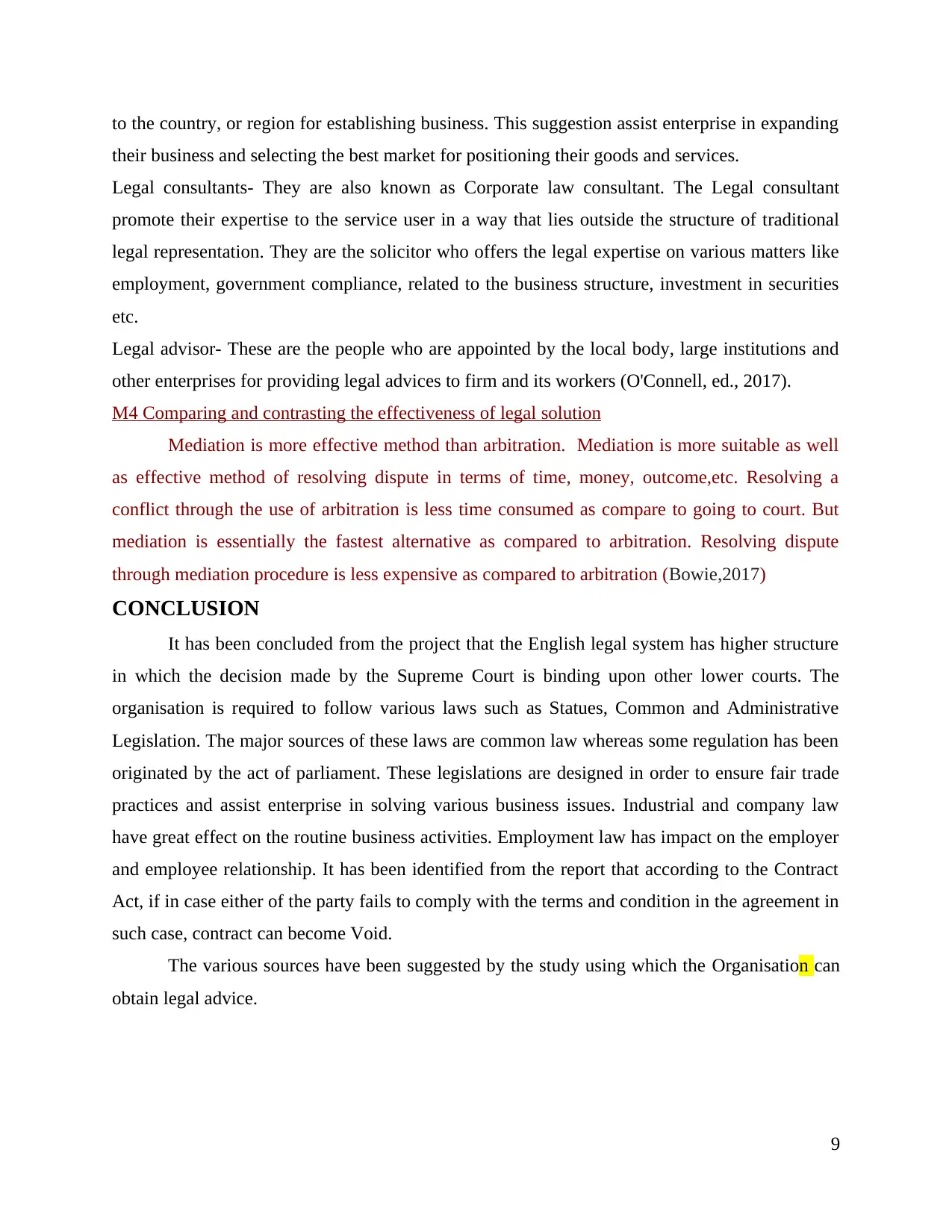
to the country, or region for establishing business. This suggestion assist enterprise in expanding
their business and selecting the best market for positioning their goods and services.
Legal consultants- They are also known as Corporate law consultant. The Legal consultant
promote their expertise to the service user in a way that lies outside the structure of traditional
legal representation. They are the solicitor who offers the legal expertise on various matters like
employment, government compliance, related to the business structure, investment in securities
etc.
Legal advisor- These are the people who are appointed by the local body, large institutions and
other enterprises for providing legal advices to firm and its workers (O'Connell, ed., 2017).
M4 Comparing and contrasting the effectiveness of legal solution
Mediation is more effective method than arbitration. Mediation is more suitable as well
as effective method of resolving dispute in terms of time, money, outcome,etc. Resolving a
conflict through the use of arbitration is less time consumed as compare to going to court. But
mediation is essentially the fastest alternative as compared to arbitration. Resolving dispute
through mediation procedure is less expensive as compared to arbitration (Bowie,2017)
CONCLUSION
It has been concluded from the project that the English legal system has higher structure
in which the decision made by the Supreme Court is binding upon other lower courts. The
organisation is required to follow various laws such as Statues, Common and Administrative
Legislation. The major sources of these laws are common law whereas some regulation has been
originated by the act of parliament. These legislations are designed in order to ensure fair trade
practices and assist enterprise in solving various business issues. Industrial and company law
have great effect on the routine business activities. Employment law has impact on the employer
and employee relationship. It has been identified from the report that according to the Contract
Act, if in case either of the party fails to comply with the terms and condition in the agreement in
such case, contract can become Void.
The various sources have been suggested by the study using which the Organisation can
obtain legal advice.
9
their business and selecting the best market for positioning their goods and services.
Legal consultants- They are also known as Corporate law consultant. The Legal consultant
promote their expertise to the service user in a way that lies outside the structure of traditional
legal representation. They are the solicitor who offers the legal expertise on various matters like
employment, government compliance, related to the business structure, investment in securities
etc.
Legal advisor- These are the people who are appointed by the local body, large institutions and
other enterprises for providing legal advices to firm and its workers (O'Connell, ed., 2017).
M4 Comparing and contrasting the effectiveness of legal solution
Mediation is more effective method than arbitration. Mediation is more suitable as well
as effective method of resolving dispute in terms of time, money, outcome,etc. Resolving a
conflict through the use of arbitration is less time consumed as compare to going to court. But
mediation is essentially the fastest alternative as compared to arbitration. Resolving dispute
through mediation procedure is less expensive as compared to arbitration (Bowie,2017)
CONCLUSION
It has been concluded from the project that the English legal system has higher structure
in which the decision made by the Supreme Court is binding upon other lower courts. The
organisation is required to follow various laws such as Statues, Common and Administrative
Legislation. The major sources of these laws are common law whereas some regulation has been
originated by the act of parliament. These legislations are designed in order to ensure fair trade
practices and assist enterprise in solving various business issues. Industrial and company law
have great effect on the routine business activities. Employment law has impact on the employer
and employee relationship. It has been identified from the report that according to the Contract
Act, if in case either of the party fails to comply with the terms and condition in the agreement in
such case, contract can become Void.
The various sources have been suggested by the study using which the Organisation can
obtain legal advice.
9
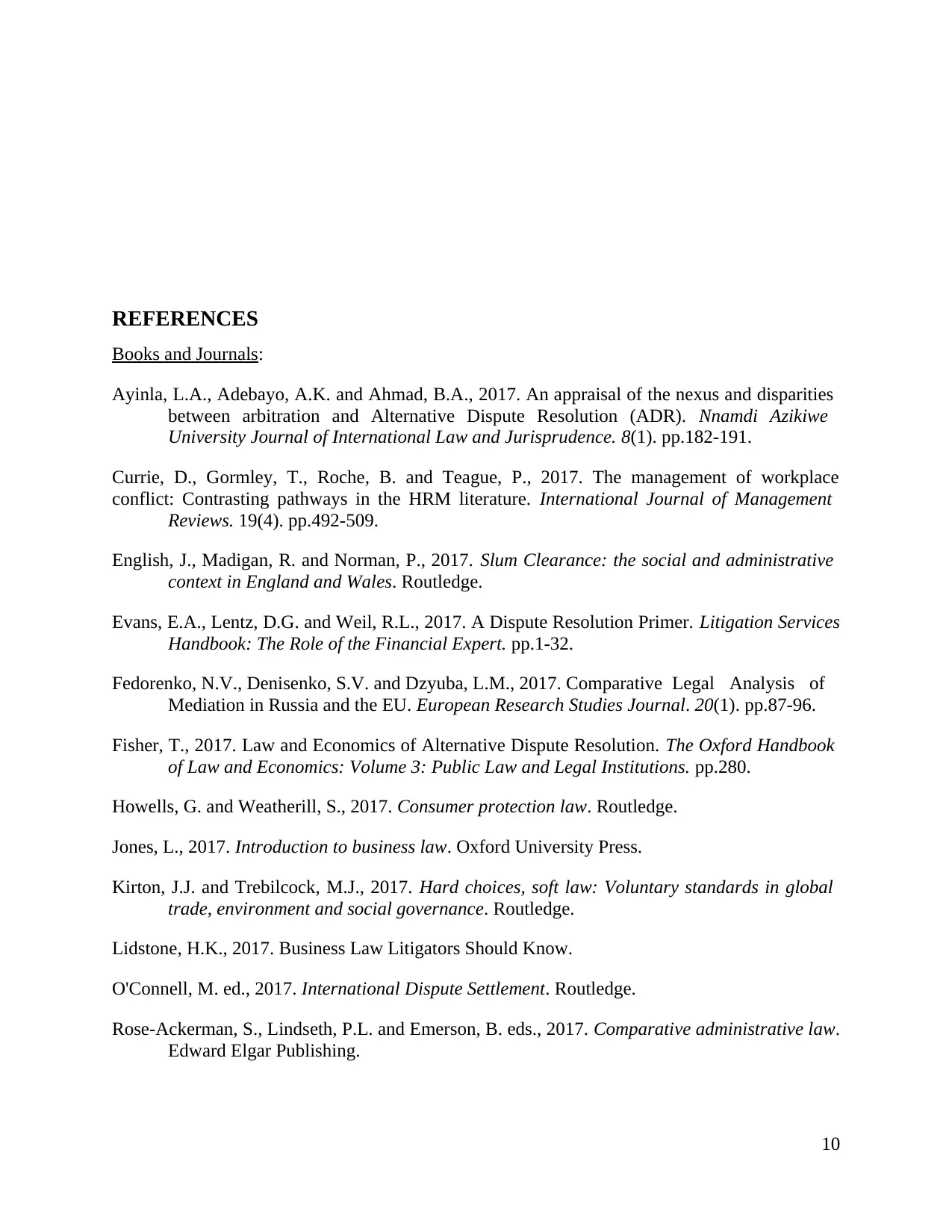
REFERENCES
Books and Journals:
Ayinla, L.A., Adebayo, A.K. and Ahmad, B.A., 2017. An appraisal of the nexus and disparities
between arbitration and Alternative Dispute Resolution (ADR). Nnamdi Azikiwe
University Journal of International Law and Jurisprudence. 8(1). pp.182-191.
Currie, D., Gormley, T., Roche, B. and Teague, P., 2017. The management of workplace
conflict: Contrasting pathways in the HRM literature. International Journal of Management
Reviews. 19(4). pp.492-509.
English, J., Madigan, R. and Norman, P., 2017. Slum Clearance: the social and administrative
context in England and Wales. Routledge.
Evans, E.A., Lentz, D.G. and Weil, R.L., 2017. A Dispute Resolution Primer. Litigation Services
Handbook: The Role of the Financial Expert. pp.1-32.
Fedorenko, N.V., Denisenko, S.V. and Dzyuba, L.M., 2017. Comparative Legal Analysis of
Mediation in Russia and the EU. European Research Studies Journal. 20(1). pp.87-96.
Fisher, T., 2017. Law and Economics of Alternative Dispute Resolution. The Oxford Handbook
of Law and Economics: Volume 3: Public Law and Legal Institutions. pp.280.
Howells, G. and Weatherill, S., 2017. Consumer protection law. Routledge.
Jones, L., 2017. Introduction to business law. Oxford University Press.
Kirton, J.J. and Trebilcock, M.J., 2017. Hard choices, soft law: Voluntary standards in global
trade, environment and social governance. Routledge.
Lidstone, H.K., 2017. Business Law Litigators Should Know.
O'Connell, M. ed., 2017. International Dispute Settlement. Routledge.
Rose-Ackerman, S., Lindseth, P.L. and Emerson, B. eds., 2017. Comparative administrative law.
Edward Elgar Publishing.
10
Books and Journals:
Ayinla, L.A., Adebayo, A.K. and Ahmad, B.A., 2017. An appraisal of the nexus and disparities
between arbitration and Alternative Dispute Resolution (ADR). Nnamdi Azikiwe
University Journal of International Law and Jurisprudence. 8(1). pp.182-191.
Currie, D., Gormley, T., Roche, B. and Teague, P., 2017. The management of workplace
conflict: Contrasting pathways in the HRM literature. International Journal of Management
Reviews. 19(4). pp.492-509.
English, J., Madigan, R. and Norman, P., 2017. Slum Clearance: the social and administrative
context in England and Wales. Routledge.
Evans, E.A., Lentz, D.G. and Weil, R.L., 2017. A Dispute Resolution Primer. Litigation Services
Handbook: The Role of the Financial Expert. pp.1-32.
Fedorenko, N.V., Denisenko, S.V. and Dzyuba, L.M., 2017. Comparative Legal Analysis of
Mediation in Russia and the EU. European Research Studies Journal. 20(1). pp.87-96.
Fisher, T., 2017. Law and Economics of Alternative Dispute Resolution. The Oxford Handbook
of Law and Economics: Volume 3: Public Law and Legal Institutions. pp.280.
Howells, G. and Weatherill, S., 2017. Consumer protection law. Routledge.
Jones, L., 2017. Introduction to business law. Oxford University Press.
Kirton, J.J. and Trebilcock, M.J., 2017. Hard choices, soft law: Voluntary standards in global
trade, environment and social governance. Routledge.
Lidstone, H.K., 2017. Business Law Litigators Should Know.
O'Connell, M. ed., 2017. International Dispute Settlement. Routledge.
Rose-Ackerman, S., Lindseth, P.L. and Emerson, B. eds., 2017. Comparative administrative law.
Edward Elgar Publishing.
10
⊘ This is a preview!⊘
Do you want full access?
Subscribe today to unlock all pages.

Trusted by 1+ million students worldwide
1 out of 13
Related Documents
Your All-in-One AI-Powered Toolkit for Academic Success.
+13062052269
info@desklib.com
Available 24*7 on WhatsApp / Email
![[object Object]](/_next/static/media/star-bottom.7253800d.svg)
Unlock your academic potential
Copyright © 2020–2025 A2Z Services. All Rights Reserved. Developed and managed by ZUCOL.





